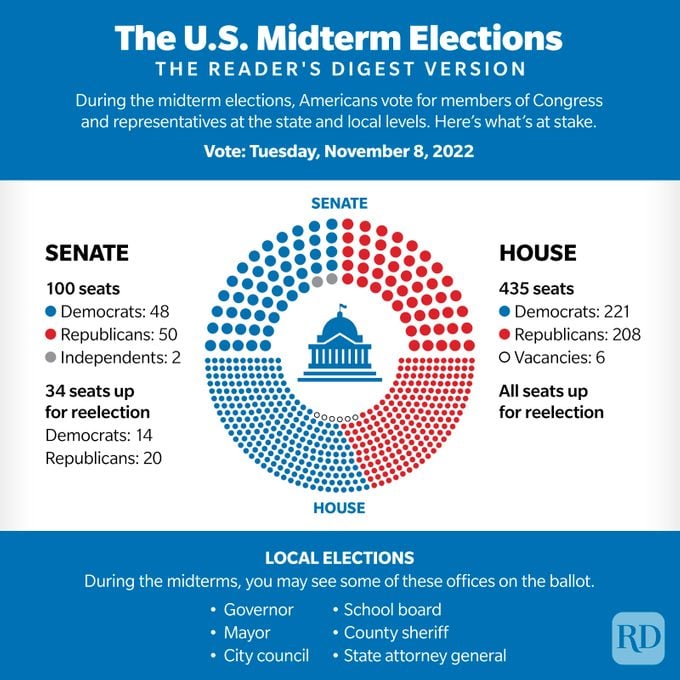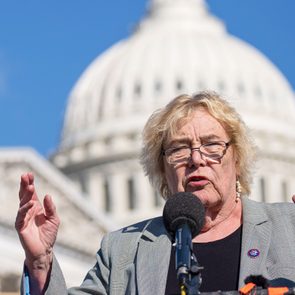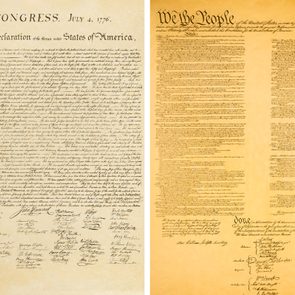What Are Midterm Elections—and Why Are They So Important?
Updated: Nov. 08, 2022

Historically, midterm elections have low turnout, but they may determine the fate of key issues this year
The Reader’s Digest Version:
|
The United States is smack-dab in the middle of midterm elections. Midterms will be held on Nov. 8, so the date to vote is coming up fast! And though they have historically lower voter turnout compared with presidential election years, midterm elections are vital to determining which political party will control Congress, so they can have a major impact on the success of the president’s agenda. “The way the midterms unfold this year will guide Republicans as they think about whether the former president or another Republican, such as Governor [Ron] DeSantis, will be the best voice for the party in 2024,” says Julian Zelizer, a professor of history and public affairs at Princeton University.
But what are midterm elections, exactly?
As the name suggests, they occur midway through a president’s term—at the halfway point, to be exact. Midterm election day is the public’s chance to vote for members of Congress and representatives at the state and local levels. The results of the midterm elections in 2022 will help determine the country’s response to hot-button issues, which is firing up a voter base more familiar with big presidential elections. “Both Republicans and Democrats seem energized about voting this fall,” says Karlyn Bowman, distinguished senior fellow emeritus at the American Enterprise Institute in Washington, D.C. “Elections are always important in a country such as ours, and 2022 will be no exception.”
This year, there’s a good reason people are asking, What are midterm elections? The political campaigns are centered around some big issues. Legislation related to Roe v. Wade and the right to choose an abortion, voting rights and voter suppression, federal policy on the Ukraine-Russia War, and inflation and gas prices could all be decided by the political makeup of Congress that results from the midterm elections. And with school shootings bringing gun control issues back to the spotlight, those elected to Congress could ignite new pressures on the fight over gun restrictions versus limiting the Second Amendment.

What are midterm elections?
Midterm elections—called the “midterms” because they occur in the middle of the president’s four-year term—are held to elect people to Congress as well as state and local offices.
Here’s a quick civics lesson, in case it’s been a while since you watched Schoolhouse Rock. Congress comprises two chambers: the House of Representatives and the Senate. During the midterms, all 435 House seats are up for grabs because representatives serve two-year terms.
Senators, on the other hand, serve six-year terms, which means that during each midterm election, a third of Senate seats—34 this year—are up for a vote. The reelection of Senators is staggered by constitutional design, ensuring that no more than one Senate seat from each state is up for a vote at the same time. “This gives the Senate a sense of continuity and experience and insulates it to a degree from, let’s say, a wave or passion that might sweep across all races,” Bowman says.
Depending on your state, a handful of other offices may be on your ballot. You might vote for governor, attorney general, mayor or local officials like school board members (particularly important in the era of renewed book banning). Moreover, states have put forth some ballot initiatives on issues ranging from campaign finance to marijuana, and you can weigh in on election day.
When are midterm elections held?
Under federal statute, we vote on a Tuesday in November for our elected officials. More specifically, midterm elections are general elections held on the Tuesday after the first Monday in November. This year, they occur on Nov. 8, 2022.
The opening and closing times for different polling locations vary depending on the state. Some states hold elections mainly by mail.
In the months leading up to Nov. 8, some states hold primaries to winnow down the field of candidates from each party so that there is just one person from each party running on election day.
What is the history behind midterm elections?
Today’s midterms differ from America’s earliest elections. Believe it or not, Election Day used to be a jubilant affair filled with alcohol, parades, cakes and parties. These days, most people squeeze a trip to the polls in between work and family obligations—or they go the more convenient route and vote by mail.
But as much as some things change, others stay the same. And throughout history, midterm elections have not boded well for the political party that controls the White House. That pattern dates back to the Civil War and has continued well into the modern presidency. Since World War II, the president’s political party has lost an average of 26 seats in the House and an average of four seats in the Senate.
Because midterm elections are often considered a referendum on the president, a serious defeat for the president’s party has often ushered in key moments in the nation’s political history. Newt Gingrich’s “Contract with America,” a platform of Republican Party principles, was a central element in the 1994 midterm elections, and it had a devastating impact on Bill Clinton’s presidency. And low turnout in the 2010 midterm elections led to Republicans taking power and the birth of modern-day Trumpism.
How many people vote in midterm elections?
In recent history, about 60% of the population that is eligible to vote does so in a presidential election, and 40% does so in a midterm election. But there are signs that more people are voting in the midterms—and that could mean higher turnout for midterm elections 2022.
There was a historic increase in voter turnout during the last midterm elections (in 2018), up 11 percentage points from the 2014 midterms. It was the highest midterm election turnout in more than a century.
That said, voter turnout is lower in the United States than in most democracies.
Why are midterm elections important?
We like to think that our vote for president is all it takes to enact change in our country. But remember, there are three branches of government. The president (part of the executive branch) relies on Congress (the legislative branch) to pass legislation and confirm justices to the Supreme Court (the judicial branch). By voting in the midterms, you have a chance to change the party in power. What are midterm elections if not a chance to cast a vote for lawmakers who support legislation that matters to you?
Worried about voter suppression? Vote for officials who oppose policies that restrict voting or make it harder to vote. Feel strongly about gun violence in America? Vote to make your voice heard.
Broadly speaking, the midterm elections determine which political party controls each chamber of Congress, based on who wins more of the individual races. Ultimately, the party that controls the House or the Senate can determine which issues Congress will consider and whether they will work with the White House on a legislative agenda.
“Midterm elections are always important because they play a big role in shaping the legislative field for the president in the second two years of office,” Zelizer says. “The worse the outcome, the more constrained his options will become.”
Right now, Democrats control the Senate by the tightest of margins, but the midterms could change that. Of the 34 seats up for grabs, 14 are held by Democrats. Since Republicans hold 50 seats in the Senate, Democrats need to keep their existing 48 seats—and win three more—to maintain a majority. (Two Independent Senators vote with the Democrats and, if necessary, Vice President Kamala Harris will cast the tie-breaking vote for the party.)
If Democrats don’t get enough votes, the results of the Senate races in the midterm may swing control to the Republicans.
Key things to know about the 2022 midterm elections
What are midterm elections? An opportunity for all Americans to impact the government on the federal, state and local levels and vote for legislators who represent the important issues of the day.
The economy is always a central concern in any election, and the 2022 midterm elections are no different. Front and center are discussions about inflation, high gas prices and the rising cost of living.
With the Supreme Court having overturned Roe v. Wade, the right to an abortion and women’s issues in general are emerging as top concerns in the 2022 midterm elections. Education, crime, jobs and immigration are also big sources of debate this year.
Races to watch include those in states where the Republican and Democratic candidates were neck and neck in the last presidential election. Some of the highest-profile races this election season are happening in Georgia, Pennsylvania and Ohio.
Ultimately, though, the results of the midterms may show the direction the country is heading politically, according to Bowman. “The country is deeply polarized on most political issues,” she says. “Elections give us an ability to see where the political center of gravity is.”
Sources:
- Julian Zelizer, professor of history and public affairs at Princeton University
- Karlyn Bowman, distinguished senior fellow emeritus at the American Enterprise Institute
- Fair Vote: “Voter Turnout”
- History.com: “The 1994 Midterms: When Newt Gingrich Helped Republicans Win Big”
- U.S. Census Bureau: “Voter Turnout Rates Among All Voting Age and Major Racial and Ethnic Groups Were Higher Than in 2014”
- Brookings Institution: “Losses by the President’s Party in Midterm Elections, 1862–2014”
- Ballotpedia: “State Poll Opening and Closing Times (2022)”
- Ballotpedia: “All-mail voting”


















